Month: April 2020
It may have been the most thoughtless senior prank I ever experienced.
As a former high school principal, I don’t love senior pranks. Usually, very little thought goes into them, and they end up being destructive, damaging, or time consuming. Occasionally though — and I mean very occasionally — a group of seniors pulls off a truly clever idea that is not at all destructive, damaging, or time consuming. A few years ago, seniors brought their pets to school. It brought a lot of smiles to campus, and some students declared it the best day ever. My mistake was not saying it was a one-time only event, which I had to say when the next year’s students tried to do the same thing. Clever one year, and inconvenient after that. I know that with my cat allergies, I would not like Bring Your Cat to School Day. But we all know the cats wouldn’t like it either.
During my time as a high school principal, the second-best senior prank was when some students, with inside help, moved my entire office, desk, chairs, bookshelves, everything, into the quad. I “had to” work outside the whole day, holding meetings in the bright sun, and making a spectacle of it all.
But the best prank was when a group of seniors spent months deconstructing a Volkswagen Beetle and then one night rebuilt and secured it around the flagpole in the quad. When I came to work, students and employees were admiring a VW Bug in Malibu High School colors with the campus flagpole rising through the middle of it. It was awesome, and I let it stay there for a week. And when I asked the students to take it down and leave the quad in perfect condition, they did just that. Spectacular.
Back to the thoughtless prank. Some seniors at Santa Monica High School had released about 200,000 ladybugs on campus. I’m not sure that was the number, but that was the rumor. It was a lot. Ladybugs blanketed several hallways and just didn’t know what to do. I’m sure there were rose bushes all around town that would have loved them, and local aphids should have been fearful, but instead the ladybugs were just clogging up the hallways, getting stepped on by people trying to leave the building, and eventually being removed by custodians. It was a needless loss of life for some beautiful and extremely useful creatures, and I hated it. In the course of helping to deal with the prank, I mentioned to one of the office assistants that my then-five-year-old son loved ladybugs, and he would have hated to see this. As I was leaving, the assistant gave me an emptied plastic liter bottle, punched with air holes, containing about 50 ladybugs to give to Dawson. Her unsolicited act of kindness gave me the only smile I had that afternoon, and I am still grateful.
When I came home, Dawson came outside to greet me and I gave him the bottle-o-bugs. He looked at it with big eyes, then looked at me and said these now famous words: “Thanks, Dad. I finally have a pet.”
Oh boy.
Dawson had been bugging us for a while for a dog, but he’s such an easy-going kid, that he figured lady bugs must be the next best thing. I turned to Jill and said, “It’s time to get a dog.”
That weekend we went to the local animal shelter and spotted a Pekingese that someone had dropped off at the pound’s front gate. We saw her as she was being taken out of her cage for the first time and walked around. There’s a Kenny Chesney song about his adopted dog, where he sings, “Lying there like a lost string of pearls.” It’s a perfect line for a beautiful abandoned dog. Dawson and Jill fell in love, I quickly gave up any hope of looking the least bit masculine as I walked this white fluff ball through the neighborhood, and Penelope (Penny) was ours. That was October 18, 2008.
Last Saturday, exactly 11 and one half years later, our Penny died of old age in our arms.
Those of you who have lost beloved pets know that in these deaths you lose a family member and a friend. It hurts.
But it was a great run.
There’s a touching book called The Art of Racing in the Rain, by Garth Stein. The movie is OK, but the book is special. It features the relationship between the main character, Denny, and his dog Enzo. Their close friendship is almost human in nature, and the dog understands emotions, illness, auto racing, and the meaning of the universe. I don’t think Penny understood any of those things, but she was still a wonderful dog. More from Enzo later.
Pets have been a great source of companionship during this COVID-19 era. There are plenty of Facebook posts about dogs tired of walks and belly rubs, of happy dogs, or dogs imploring their humans to go back to work. I Zoom regularly with two colleagues, one of whom has a dog always begging to get picked up so he can co-Zoom from her lap, and another who has a cat who lurks behind her, ready to attack, like Cato in the Pink Panther movies. Our pets and companions, intelligent, loving, or diabolically crazy, make our lives so much more full, which is particularly reassuring while we are spending so much time at home with plenty to worry about.
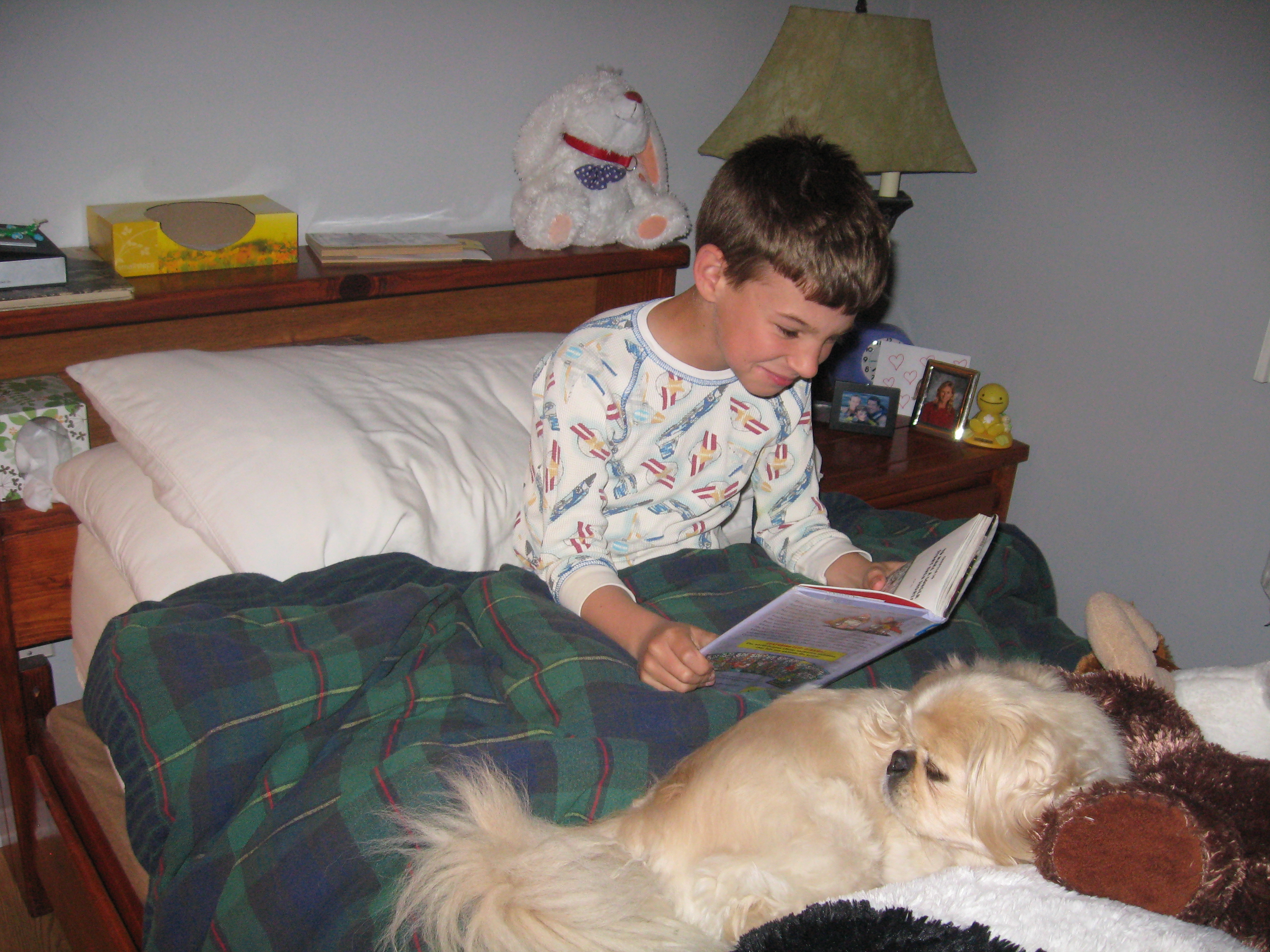
We adopted Penny when she was four or five, when Dawson was also four or five. They grew up together. She slept at the foot of Dawson’s bed, they played together in their younger years, and when they were older, you could usually find her lying on a soft pillow next to Dawson as he sat at the computer. She didn’t need much: a little food, occasionally with some cheese mixed in, clean water, access to the back yard, and short bursts of companionship. She spent most of her time just looking for a soft place to sit, close to us, but not too close. We called her a cat-dog. She liked us, but didn’t need us, except when she did. We loved her in spite of or because of all of that.
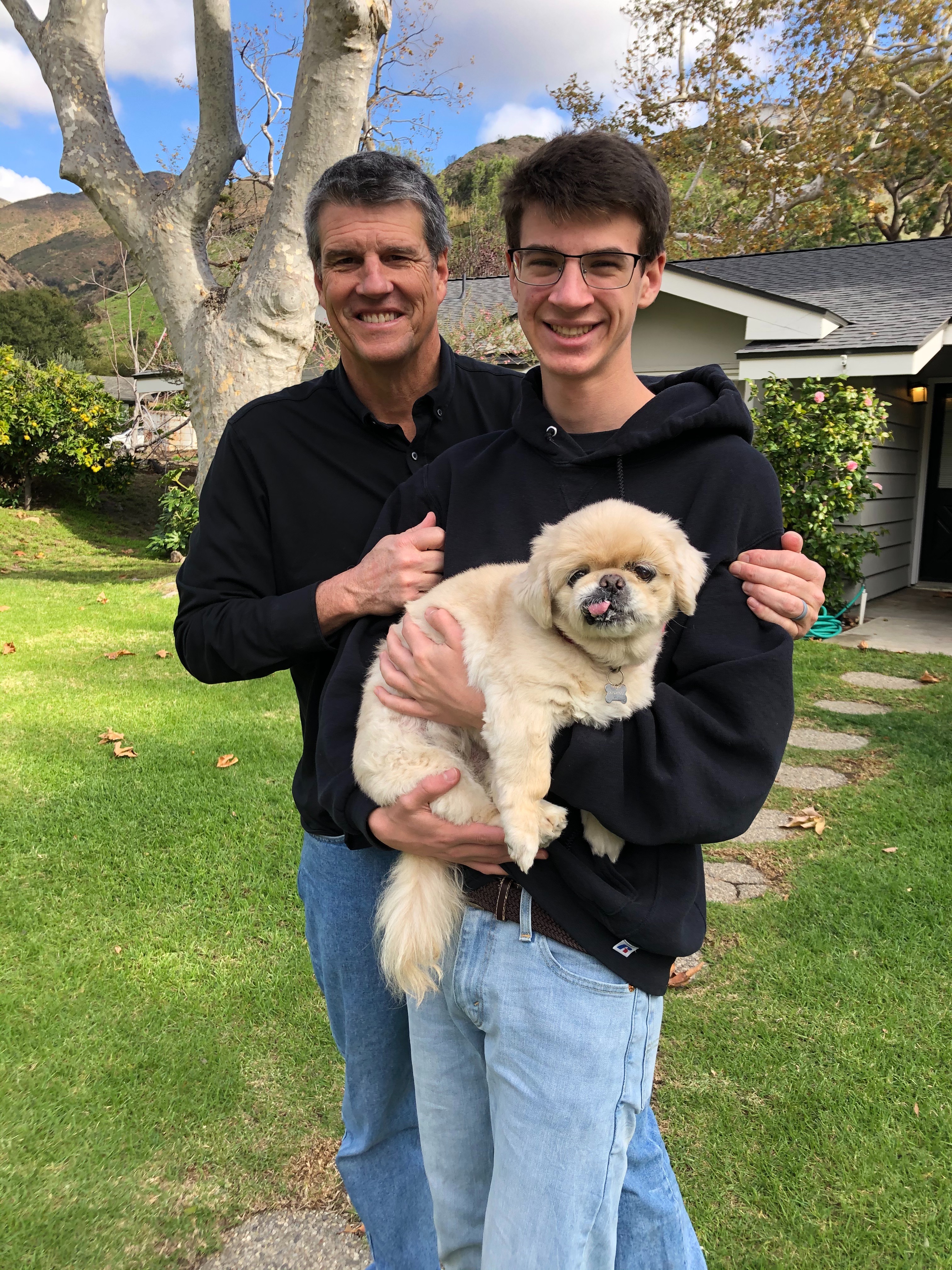
“Dogs’ lives are too short. Their only fault really.” I found that quote from Agnes Turnbull, and I couldn’t agree more.
I have never spent more time at home than in the past few weeks. Never. One of the gifts of that time was getting to spend so much time with Penny in what turned out to be her final weeks with us. All of us being with her at 3 a.m. when she breathed her last breath was powerful and emotional. She knew she was loved, and though I was not ready, I believe she was.
Back to our dog philosopher hero Enzo, who philosophized, as only dogs can do, “To live every day as if it had been stolen from death, that is how I would like to live. To feel the joy of life, … to separate oneself from the burden, the angst, the anguish that we all encounter every day. To say I am alive, I am wonderful, I am. I am. That is something to aspire to.”
I am convinced that many of us, when it comes to the pursuit of happiness, are our own worst enemies. We humans overthink things, and the more leisure time we have, the more we overthink our lives. We should learn from our dogs.
One last quote from Enzo the wise sage/dog: “That which is around me does not affect my mood; my mood affects that which is around me.”
We are living in the midst a very challenging time. If we can take the time to step back from our challenges, feel the joy of life, and seek to improve the moods of those around us, that’s good stuff.
Thank you, Penny, for making our moods better every day of your 12 years with us.
May all of your animal friends, dogs, cats, horses, and even ladybugs, past, present, and future, ease your burdens and bring smiles to your faces throughout your lives.
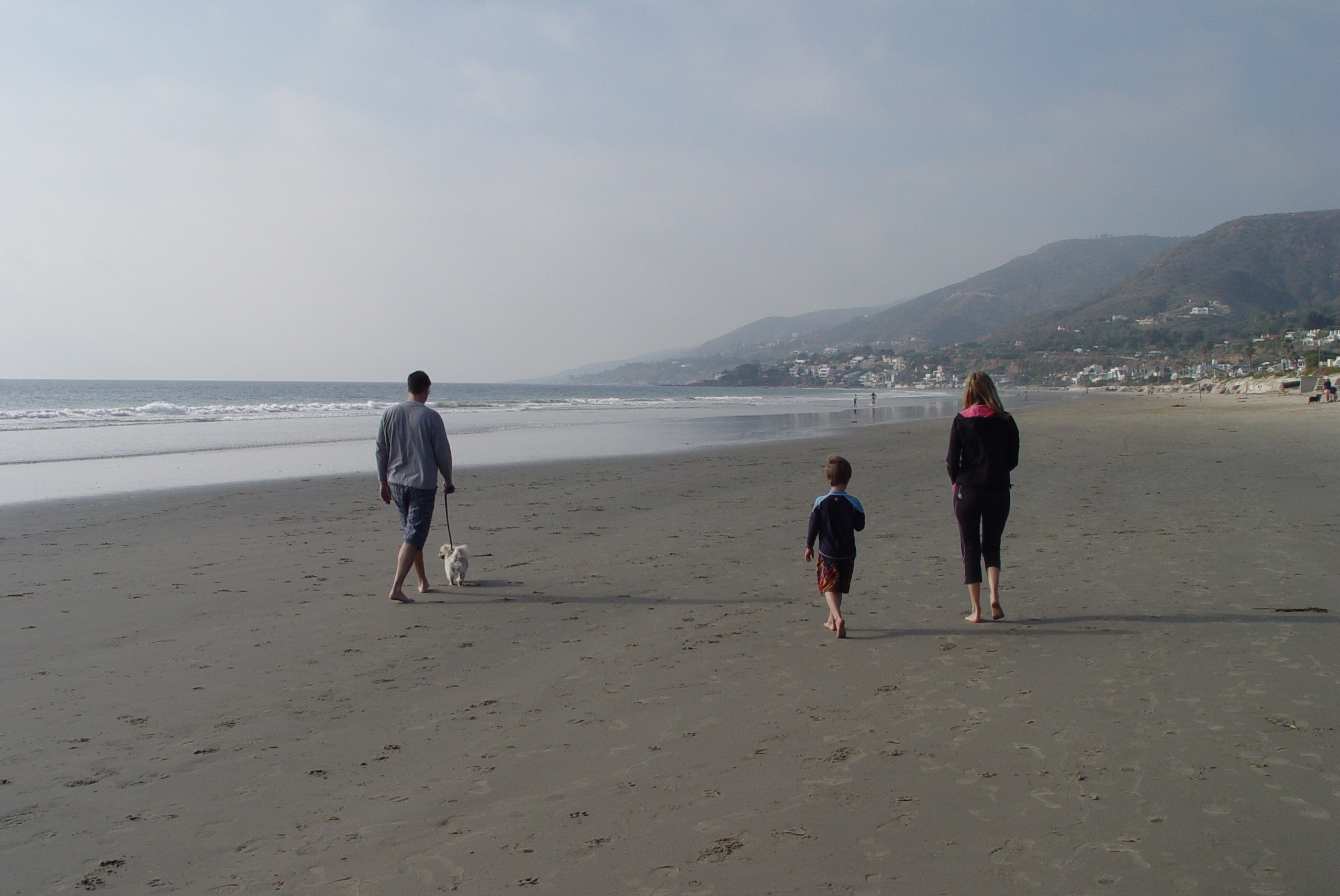
“I have raised an illiterate son.”
Those were the words my dad spoke to me as a 17-year-old, as I was filling out my Harvard application. Harvard required that we list all the books we had read during high school, and left plenty of room on the paper application to fill in lots and lots of books. I only really had the books I had been required to read in school, and there were acres of space left on that part of the application. I didn’t think Harvard wanted to hear about Great Linebackers of the NFL, and Great Quarterbacks of the AFL, or even Strange But True Football Stories. So, I left a lot of blank space and disappointed my Dad. Apparently, Harvard wasn’t impressed either. Oh well. I left high school as a decent reader and writer, and since then, I have tried continuously to get better. I still don’t read as much as my dad does, but I know my dad considers me to be at least semi-literate now, and every week we discuss books and recommend new finds to each other. Jill wonders if my dad’s comment is the reason I keep an annotated bibliography now. Maybe.
I think I have written more in the past five weeks than at any time since I finished my dissertation. But I’ve actually enjoyed this writing. It’s allowed me to reflect on how I evolved from my high school writing self to the writer I am today. I did not get here alone. I had mentors who inspired and guided me along the way.
I’ll begin with my father. If I had a nickel for every time he said, “I wish people in this world could just write a simple, clear, declarative sentence,” I’d have a hundred bucks at least. And I could at least do that when I left high school. But he was also a writing model for me. When I went to college, and phone calls were too expensive to make, I could count on getting a letter every day from my dad. Every day. Sometimes typed, often written in his left-handed scrawl. It was great either way. I did not write back as often as he would have liked. One time, he sent me a typed letter with fill-in-the-blank spaces, and asked me to fill it out, put it in the stamped addressed envelope, and mail it back to him. The letter went:
Dear Dad,
I am doing ____________.
The weather here is ____________.
One thing I did today was __________________.
Love,
Mike
Hilarious.
In December of every year, my dad sends all of his children a summary of quotes from his favorite books and articles that he read during the year. He’s still a role model and a writing mentor.
The first teacher in my life who truly took an interest in my writing and served as a writing mentor was my advisor in college, Dr. Alexander George. I’ve mentioned him before. As an International Relations major, I felt fortunate to take two classes on the Soviet Union from Professor George. He was the first person to pull me into his office solely to discuss my writing. He called me “a diamond in the rough” in terms of my writing. For those of you familiar with the Disney version of Aladdin, the person who was called a “diamond in the rough” in that movie was also called a “street rat.” Coincidence? He worked with me on going beyond the simple, declarative sentence and actually varying my sentence structure, and he asked me to work to interest my reader. He was one of the foremost researchers in the world, and he took time to help out a street rat. I was fortunate to have his honest and kind mentorship.
My next mentor did not come around for a few decades after that. I call her a Person Who Has Never Applied for a Job. I also call her one of my closest friends. I met Pat Cairns in 1993 when I became principal at Malibu High School. She was an English teacher, and she was really good at her job. So I made her quit it. I hired her as a Vice Principal (without interviewing her) and we worked together for years. She and I also team taught an AP US History/AP English 11 course, and we were quite the team. She later became an elementary principal (again without applying for the job), and that’s when she started to mentor me in writing. She wrote weekly letters to her elementary parents, and I read them faithfully. They were funny, touching, personal, insightful, and perfectly written stories for her community. They were self-deprecating, and they often bared her soul. They were courageous, as good writing often is. You put things out there that most people would keep private. It takes more time than you possibly have, and you always wish you had more. I know how busy she was as a principal, yet she found the time. She remains one of my greatest mentors, and I value all the conversations we had about her weekly letters and about life. By the way, she is also Dawson’s godmother, and she has lived next door to us since 2001. Her house burned down in last year’s fires, and she has not yet moved back. The lemon tree that stood between our houses stopped her burning, collapsing wall from hitting our house, saving our home from total destruction. I still steal lemons from that tree regularly, and when I enjoy those lemons, I am overwhelmed with gratitude for my friend and mentor, and it pains me still that I can’t walk over and visit her or even just wave at her as she tends to her beautiful roses. One day soon I hope.
I’ve never met my next mentor. I write him emails every once in a while, as I think we have a lot in common. He probably thinks of me as a creepy and annoying fan. Maybe he’s right. Chris Erskine is a columnist for the LA Times. The LA Times is a real newspaper, doing its best to stay alive. I’m a subscriber, and if you live in LA and you’ve read this far, you should be too. Click here to do just that. Chris Erskine represents the common family man in LA, and he writes about the beauty, humor, sadness, and craziness of his family, the Dodgers, good friends, and the Los Angeles community. Like Pat Cairns, he bares his soul. He recently shared the crushing losses of his older son and his beloved wife. I can’t tell you how many times I have laughed out loud or actually cried reading his columns. And he is the king of having at least one perfect sentence in every column, one that reminds you of what writers aspire to be. His courage, wit, humor, and appreciation of every aspect of daily life inspire me, and he’s a mentor without even knowing it. I feel like I know him and that he’s a friend. (That’s me being creepy again, isn’t it?) I’m not as courageous as he is. I have started a list of topics to write about, but I’m nowhere near courageous enough to write about them yet. It’s like Derek Zoolander’s Magnum look – I shouldn’t even be talking about it. I’m nowhere near ready.
Finally, I have mentors who care enough about me to take the time to review what I write. My best friends and closest colleagues aren’t much into sugar coating. They tell it like it is, and I thrive on that. As a school superintendent, I send out a lot of writing. Pressing the “send” button on an email going to 10,000 people is always a nerve-wracking experience. I’ve seen a meme of a sweating finger lingering over a “Send” button, and that’s how I feel every time I send out a bulk email or publish a blog post. I feel fortunate to have people in my life very willing to closely read what I have written and correct and critique it before I push that Send button. They will never get me to overcome my fear of the semi-colon, but they are an incredible resource for me. I value their friendship, and I have become a better writer through their critiques.
So what does all this have to do with COVID-19? This stay-at-home era leaves us more time than ever for reflection, and there is no better way to force yourself to reflect than to have to clarify your thoughts through writing. Writing these blog posts has helped me to better understand what I’m feeling in these days. On top of that, there is so much that I can’t do in this era, so to have something new that I’m motivated to work on is energizing. I wake up early in the morning on a day where I know I’m going to write, and I jump out of bed eager to start. (Yes – I am a jump-out-of-bed person, no apologies.) Writing also creates an opportunity to appreciate and express gratitude for all that we have and for all of the people who have helped us along the way. I hope you have had mentors in your life who helped you with one skill or another. Writing even a quick email or note to them (my Dad would be happy to make a template for you!) could be a wonderful thing for both of you. And finally, what better legacy can you leave in life than actually being a mentor yourself? It’s not easy. My main job as a teacher was using history as a means of coaching and mentoring students to be better writers. However you mentor, it requires finding time that you don’t have. It means sometimes stopping, slowing down, and giving your undivided attention to helping someone else. It’s a good time to be a mentor. Now more than ever, it’s the personal connections that matter the most.
Note on October 26, 2020 – Thanks to reader Bob L. for pointing out that some of the links need updating. And sadly, Chris Erskine no longer works for the LA Times, but happily, he’s still writing and you can find his musings at https://chriserskinela.com.
I’m a big fan of reading. But I have found that reading various news feeds on my iPad, computer or iPhone, while informative, does absolutely nothing to calm my soul. In fact, as I get pulled into the various rabbit holes courtesy of social media, I find myself actually feeling more stress – it’s not relaxing! But books – that’s a whole other matter. Books I can get lost in. And sometimes, especially in times like these, it’s nice to get lost.
I remember when I got my first iPad back in 2010. I downloaded the Kindle app, and I was re-reading one of my favorite books, The Power of Now, by Eckhart Tolle. I remember coming across a passage describing the concept of “flow.” I looked up the concept using the web browser on the iPad, and saw that the book most people referred to about flow was Mihaly Czikszentmihalyi’s Flow: The Psychology of Optimal Experience. So, I bought it right then and there, read it, then came back to The Power of Now. I felt like I was living inside of a library, but I never had to leave my house. Besides the fact that the books weren’t free like they are in our marvelous public libraries, it was amazing!
I remember back in college I had a job doing research for Dr. Alexander George, one of the preeminent Soviet Union scholars in the world. He would ask me to get books from the Hoover Library, which was a giant tower located at the heart of the campus, filled with papers and books. For a lowlife student like me, there was no wandering of the halls in the Hoover Library. You went in, politely requested the book from the people on the bottom floor, and came back later to pick it up. Just 26 years later, the Kindle was changing all of that, where the even most obscure books are usually at our fingertips. Amazing.
Anyway, back to flow. Czikszentmihalyi (click here to see how to pronounce) wrote, “I developed a theory of optimal experience based on the concept of flow—the state in which people are so involved in an activity that nothing else seems to matter; the experience itself is so enjoyable that people will do it even at great cost, for the sheer sake of doing it.” What a concept. He believes that humans are highly distractible as a modern species. “Contrary to what we tend to assume, the normal state of the mind is chaos.” As someone who can be distracted (squirrel!), it feels good that I’m maybe not that different from most people. Czikszentmihalyi believes that flow is not easily achieved. “Anyone who has experienced flow knows that the deep enjoyment it provides requires an equal degree of disciplined concentration.” If you’d rather hear him than read the book, he gave a great Ted Talk where he goes into detail about the kinds of experiences that can create flow for different individuals. These intrinsically rewarding flow experiences present a high level of challenge, for which we must have the requisite level of skill. It’s yet another Ted Talk worth listening to.
My friend Ali from Beach Cities Health District (BCHD) was one of the first subscribers to this blog feed. She recently suggested that one of my next blogs should be on this concept of flow. I spoke about flow at a BCHD event, and she and I have had many conversations about it since then. We do a lot of work together on how we can promote happier, less stressed, and more fulfilled students and adults in our community. That work, and the concept of flow seem particularly relevant now, in a time when chaos seems to be all around us.
There is a big difference between downtime and flow. Downtime is time spent tuning out, pulling back, or turning off. There’s nothing wrong with downtime! Highly enjoyable downtime for me is time spent watching sports on TV, watching West Wing or Ugly Delicious on Netflix, playing Catan, Cribbage or Mah Johngg with Jill, or other casual events that are highly enjoyable, but require neither advanced skills nor full concentration. My mind can wander during these downtime activities, and sometimes I even multi-task (don’t tell Jill!).
But to achieve flow, you have to concentrate. You have to focus. It is temporary and can be fleeting. I think a lot about my pursuit of experiences where I can achieve flow. All of us have different ways of getting there. Other than reading, which I described above, here are some of my favorite flow-inspiring activities:
- Problem solving. Anything at work where I am truly problem-solving can get me into a state of flow. This can be researching on my own, but more often it is putting heads together (or these days, Zooming together) with my colleagues, spending time fully devoted to moving towards a solution.
- I still love teaching. I occasionally teach graduate level courses as an adjunct professor with Cal State Long Beach. I will walk into a 6 PM course that will last over three hours, saying to myself, “Why did I ever agree to do this? I’m exhausted, I want to get home, and I have a zillion things that need to get done.” When I walk out at 9:30, I am saying to myself, “That was spectacular! I loved every minute, I’m energized, and I can’t believe the time flew that quickly!” That is flow.
- I lose myself in cooking whenever I can. I cook for my family, and I have catered for over 100. I cook in my indoor kitchen and my outdoor kitchen. I love learning and talking about cooking with friends who are amazing cooks, and time flies when I’m in the kitchen. I keep my recipes on a website to share with friends and family. Cooking is not downtime. It requires concentration, planning, organization, and (bonus) it can be done well with a glass of wine in your hand.
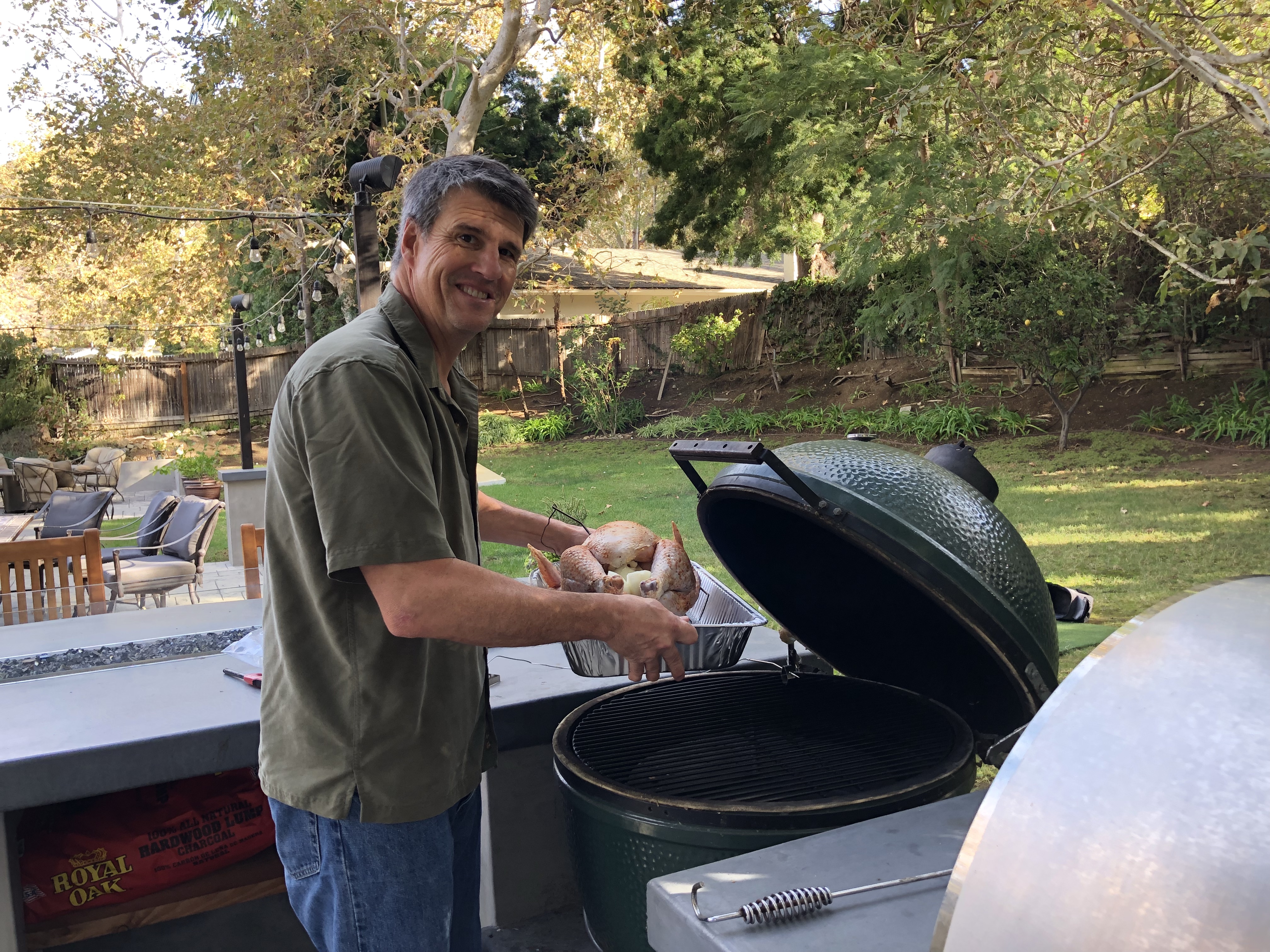
Getting ready to smoke a turkey on the Big Green Egg!
- Three days a week at 5:30 AM (maybe 5:33), I jump into the beautiful LMU pool and swim hard for one hour alongside swimmers who swim at a similar pace to me. Coach Bonnie or Clay gives us organized workouts and push us. When I swim on my own, I’ll swim 1500 yards at a decent pace and get out. My mind is wandering and I enjoy it, but it’s not flow. When I’m coached, I swim at least two miles, I am pushed to move faster, and I’m competing with Wayne, Cat, Karl, Nader, Kelly, Shauna, or whomever is in the lane next to me. While we swim, there is no time to let my mind wander. This is a battle. There is strategy. There are winners and losers. And when it’s over or between swims, there’s good natured banter to be had. I love it, and in normal times, I lose myself in it for one hour three days a week.
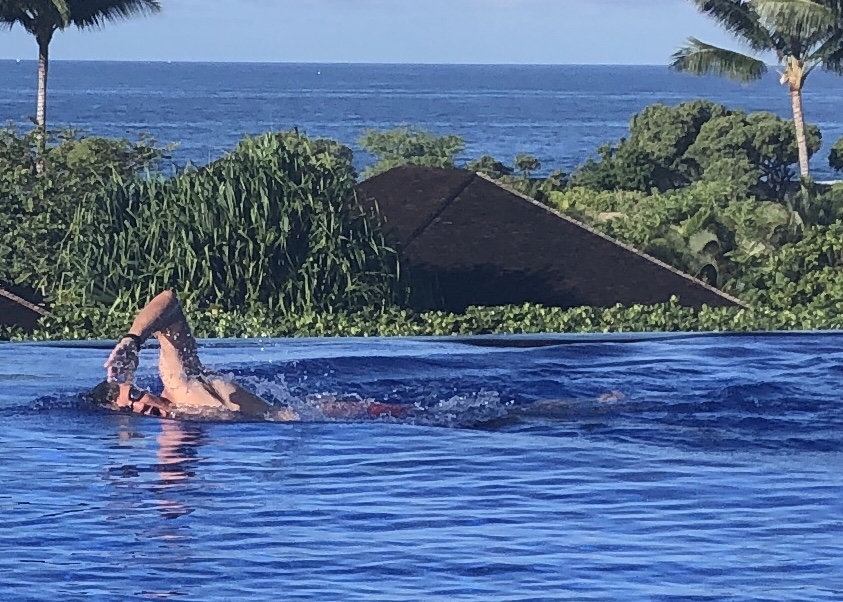
OK – So this was from a pool in Hawaii – Not LMU. A-flow-ha!
Flow sometimes comes in many other forms for me – bicycling, golf, hiking, playing music, and – I hate to admit it – in channeling Marie Kondo and decluttering my life. I do love those activities, but I’m not as skilled in them as I am cooking and swimming, so the state of flow can be a little more difficult to attain.
One of the most difficult things for me in this COVID-19 time is that many of my favorite flow-inducing activities are now unavailable. Channeling Adam Ant, “Can’t swim, can’t golf, what do you do?” Well, I’m biking more, cooking A LOT (though only for my family), and, in this very new and still mostly unknown world of distance learning, doing a whole lot of problem-solving at work.
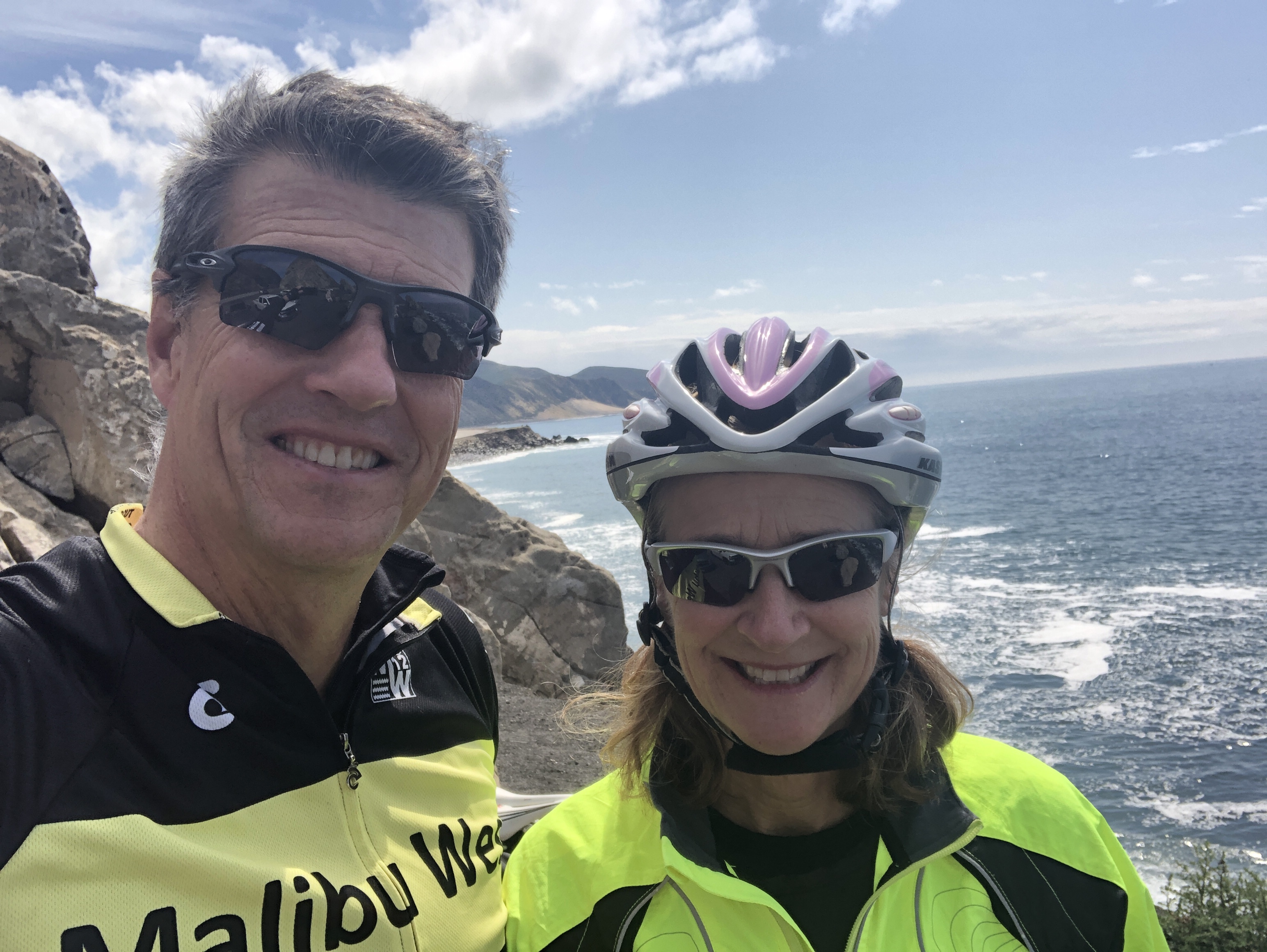
Jill and I biking the Malibu Coast last weekend.
The state of flow is worth seeking every day, or at least several times a week. Sometimes, we think we are too tired to do the work, but the reward is worth it. We can’t spend our lives in it, but we can make the effort to make sure it is a part of our lives. The key is finding a few experiences that you love, and committing to improving and becoming skilled enough to perform at flow-attaining levels. Regularly experiencing life where you are so immersed in what you are doing that time ceases to exist is a spectacular way to relieve stress and feel like we are making the most of our brief time on this planet.
Go for it.
I did not have any counselors in my high school. We had an English teacher, Mr. Bersey, who offered to help students in the college application process, but that was about it. Overnight, he went from being my sophomore year English teacher who taught me words like zephyr and zenith and who also gave me many days of Saturday school for my smart aleck comments, to the person I went to for advice when I had questions about college application process. It wasn’t much, but having someone who knew something, as opposed to relying only on the heavily dogeared college application books I was reading, was helpful.
With the exception of what seemed like 37 years in middle school, I led a pretty charmed life through high school and never had anything close to a need for counseling. My parents divorced immediately after I left for college, and the 2000 miles of distance spared me from having that pain in my face every day. My younger brothers and sister were not so fortunate. But life has a way of eventually bringing its share of pain to all of us. The longer you live and the more you listen, the more you know that. I’ve had my share of pain since my twenties, and counseling helped me get through the hardest times. Having someone to talk with, to listen objectively, to question and push, and to call me on the carpet on some of my thinking has helped me tremendously at key points in my life.
As a high school principal, I got to work closely with school counselors. I considered our counselors to be a vital part of my leadership team. In many cases, counselors know students better than anyone, and their insight is often essential to making high quality instruction possible. I spoke last week with the counseling teams that support the students at Mira Costa High School and Manhattan Beach Middle School. I am grateful for the time they shared with me and loved being able to spend an hour with each team, hearing about how they are transitioning to “distance counseling.” I continue to love how Zoom connects us during this crazy time. I have spoken with our counselors many times, but seeing them working from their homes, talking with the group while also attending to the needs of their sometimes very young children, and balancing work and life in this new environment made me feel even more connected with this team of very caring people. All of us smiled when we heard that one of our counselors just witnessed her oldest son take his first steps.
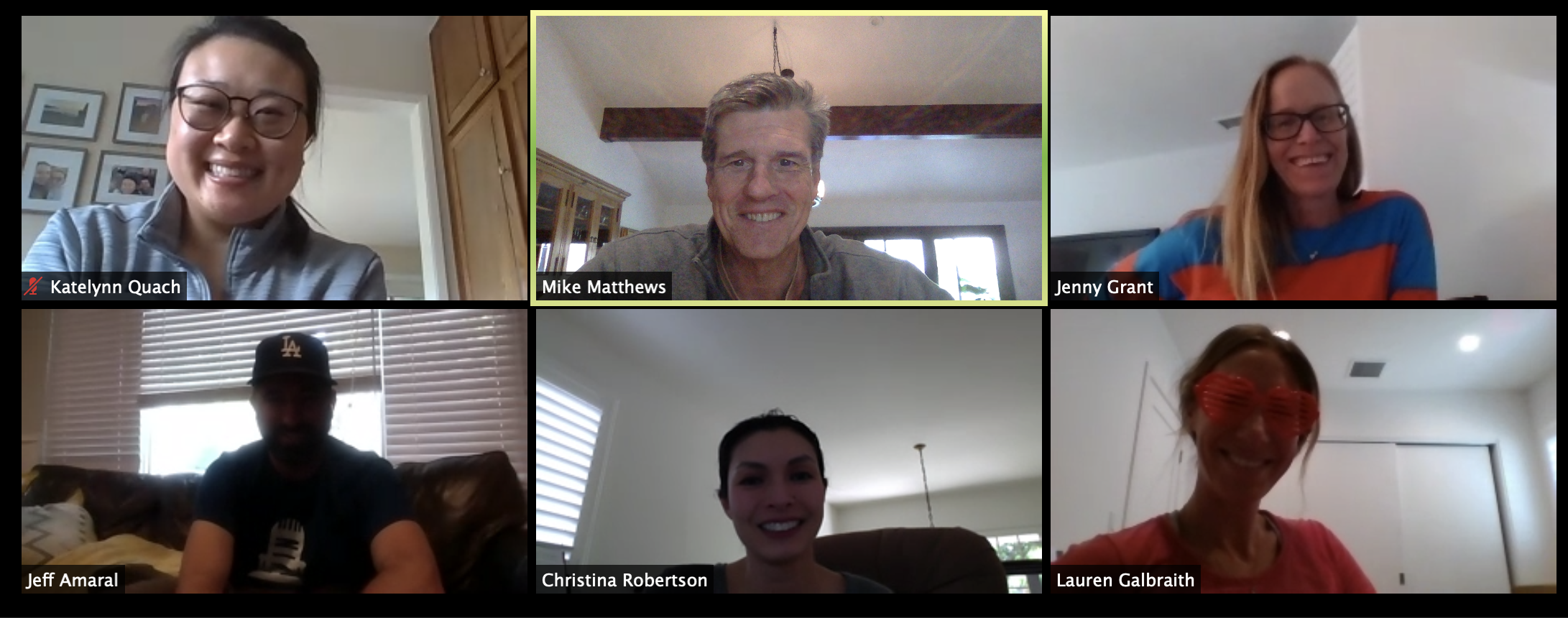
The MBMS Counseling Team
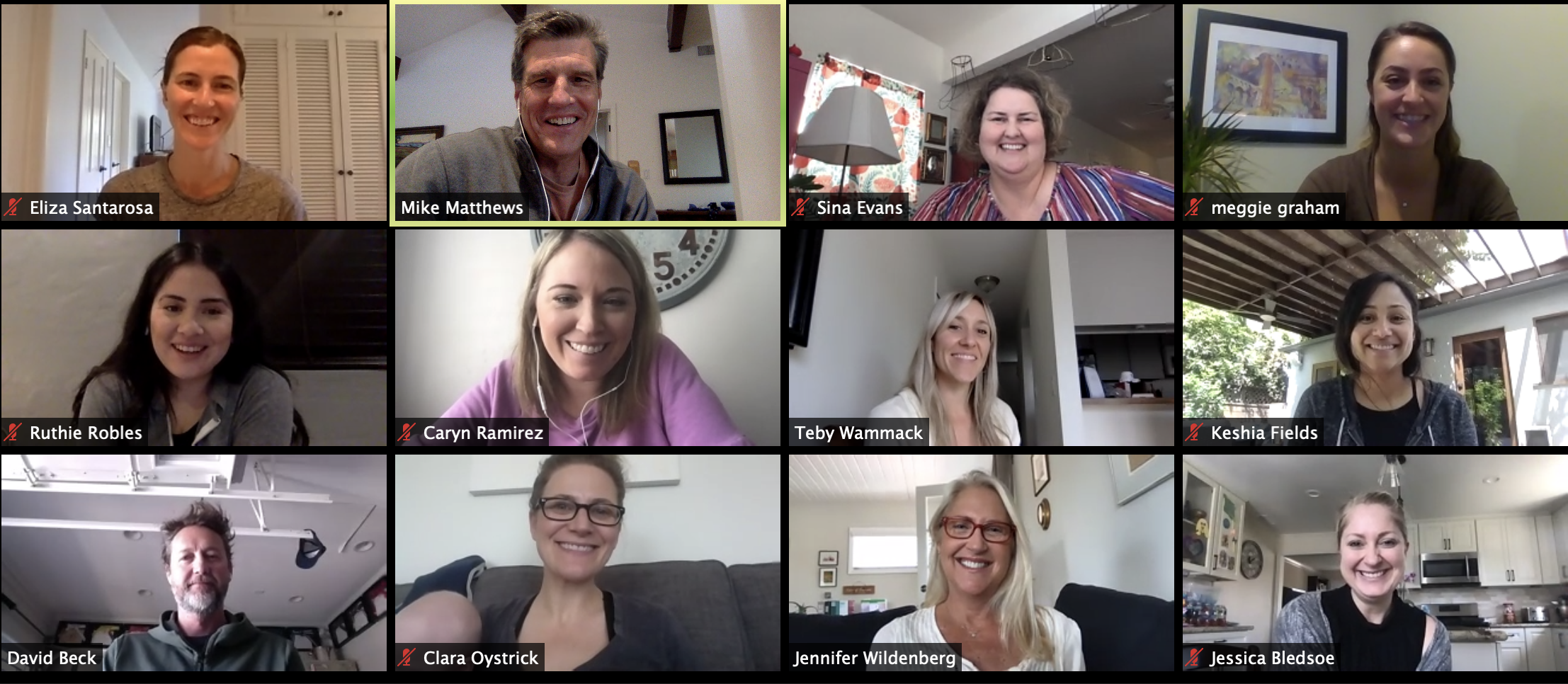
The Mira Costa HS Counseling Team
What a critical thing it is to have people in an organization who are solely devoted to helping students make good decisions and helping them get through difficult times. I wanted to speak with our counselors to learn how they are able to do this without the in-person connections and day to day interactions of regular school.
One of their top priorities has been supporting students who were already in crisis while they were in school prior to March 13, our last day of normal school. Stress and anxiety are real in our high-pressure community. Expectations are high. Some students seemingly thrive on that, but it can be too much for others. It’s often hidden, but many of our students, and students across the country, are in a lot of pain. It made the cover of Time Magazine a few years ago. All of our counselors see students who are in crisis, and this move to distance learning creates an even less connected world that could be even tougher on students. Our counselors recognize this, and when we moved to our distance learning model they immediately began reaching out to these students to try to maintain the connections they have already built and to provide a familiar touchpoint for students who need one. Their conversations are often about school, but they are more about emotions, mindsets, and the tools that students can use to process and cope with self-doubts and sometimes giant challenges in their lives. It is reassuring and comforting to know that our counselors are taking the initiative and maintaining relationships with students during this COVID-19 time.
Our College and Career Counselors have been busy as well. Mira Costa seniors have heard from colleges and are making decisions on where to attend, without the ability to visit their prospective colleges, on where to attend. Counselors have been having telephone or Zoom meetings with the families of our junior students, who are starting the college application process now. It is a crazy time for them, too. Our college and career counselors recently sent out the April edition of the CCC Newsletter as another way of keeping our students and families informed. My son Dawson is a junior. He took the SAT back in January, and now we are not even sure if schools will be accepting SATs. I’m not certain my older son Ryan would have gotten into any competitive university without his SATs. He was not a big believer in turning in homework, and his GPA reflected a stubborn adherence to that lack of belief. But he was born to take tests, and that helped him. As he still tells me regularly when we reflect on those high school days, “It all worked out, didn’t it Dad?”
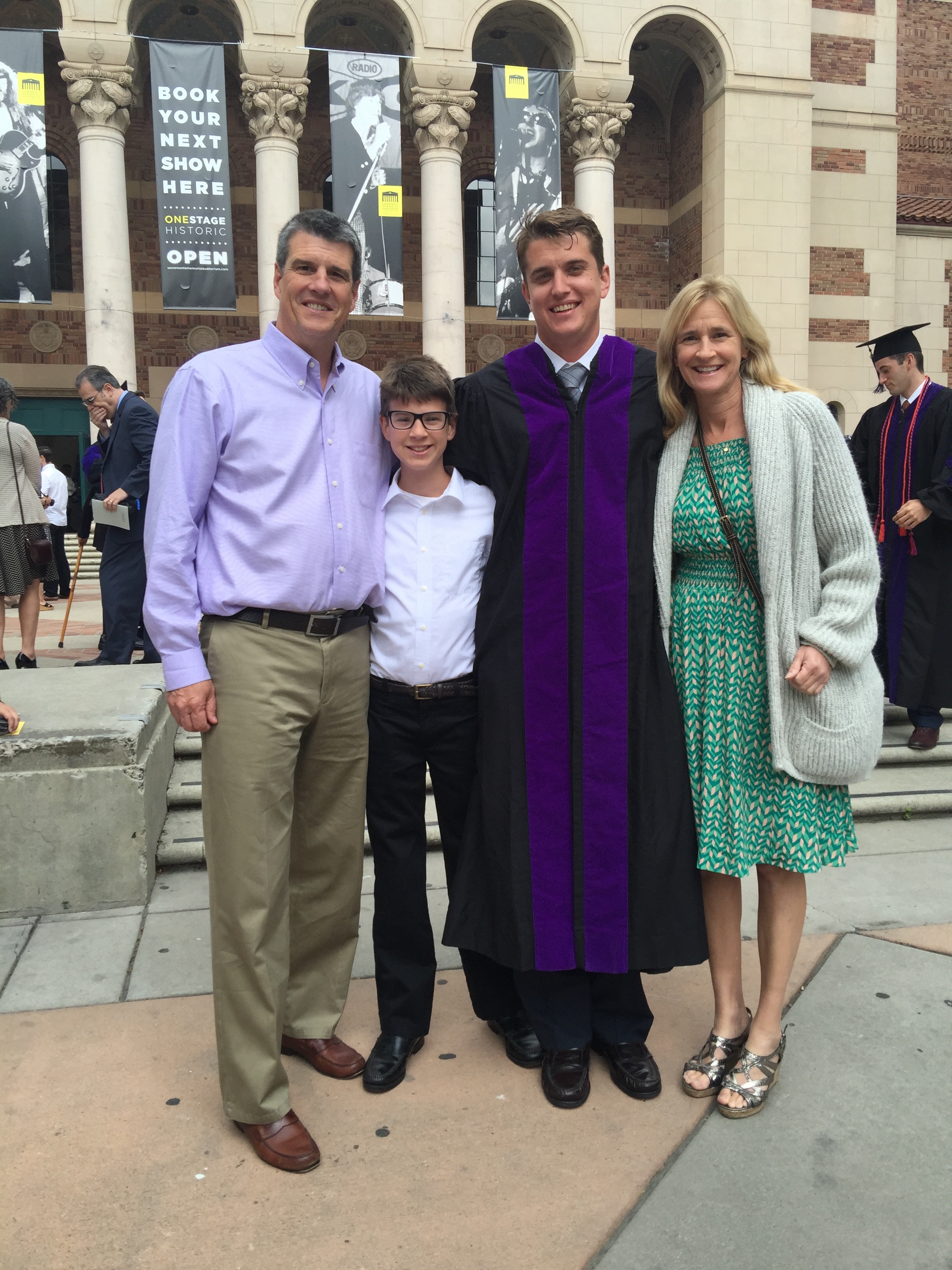
Our family celebrating Ryan’s law school graduation. Yes, Ryan, it all worked out!
It worked out for Ryan, but for Dawson, and for all of our juniors, the college application process has never been more uncertain. Our counselors are trying to guide students and families, meeting with them and their families through Zoom to help them navigate a process that none of us yet understands and that is changing as we go. To me, the main point we need to remember is the point that Frank Bruni repeatedly makes in Where You Go Is Not Who You’ll Be. Successful people are not successful because of the college they attended. It’s about their desire to learn, to improve, to take chances, and to work hard through all of it. Bruni writes, “What drives earnings isn’t the luster of the diploma but the type of person in possession of it…A good student can get a good education just about anywhere, and a student who’s not that serious about learning isn’t going to get much benefit.” Channeling Frank Bruni to all of our high school students, our middle school students, and parents – it’s going to be OK.
Our counselors reminded me that life goes on even in this time of social distancing, and that sometimes brings hardship and pain. As they learn about new and sometimes very heavy circumstances that our students are facing, our counselors are reaching out to support them as well. One of our students just learned that his mother has cancer. Other students have witnessed a parent or grandparent go through COVID-19. We have students whose parents are on the front lines in the medical profession, risking their health every day. Financial stresses are straining our families. The health, the emotions, and the lives of the ones we love matter more than anything. Having a trusted adult to talk with outside of the small circle of people with whom we are sheltering in place is sometimes critical to being able to get through difficult situations. Our counselors are working to provide this for students as they go through these real challenges, and I know that it helps.
I’m also grateful that our counselors are not alone in this work. We have so many teachers, instructional assistants, school staff, and administrators who have connections with our students, who love and care for them, and who are still connecting and listening. I know that these trusted adults are providing important and much-needed support, sometimes explicitly and sometimes just by letting students know they are still here. I have often said that teaching is not solely based on traditional content and that the best teaching happens when teachers focus on growth – and not just on academic growth but also on students’ growth as people. My wife used to be an AP Calculus teacher, and now she’s a 5th grade teacher. She talks about how people ask her, “What do you teach?” and for many years her answer was, “Math!” Now when people ask, “What do you teach?” she says, “It’s not a ‘what,’ it’s a ‘who’….I teach 30 individual students.” Meeting each student where they are, knowing what makes them tick, and helping them to grow into the people they will become is way more important than making sure that they remember every single fact and figure that we teach. As Paul Simon sang, “When I think back on all that crap I learned in high school. It’s a wonder I can think at all.” I’m a big fan of the idea that as many adults in the school as possible should teach students to think, to be creative, and to solve problems (that is not the crap that Paul Simon was talking about), help students to grow into good and caring human beings, and support students so that they know without a doubt that adults in their school care about their success a person.
Thank you to our counselors for caring for our students, particularly in this time of social distancing. Thank you to everyone in our schools who is reaching out to do the same. And let’s all remind ourselves that we are in the midst of a brutal time, and that kindness and love are more important than ever.